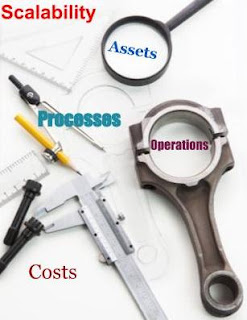Scalability in Operations Management
Scalability
What is it?
It seems that this term, Scalability,
is used by managers rarely. However you can meet it within MOOC
courses, devoted to business and operations management or manufacturing
systems. According to the analysis of publication (Putnik et al., 2013) Scalability
within the manufacturing community has started to gain major attention
since approximately the year 2000. G. Putnik and co-authors depicted
dynamics of number of papers by the search terms ‘scalability AND
manufacturing’ in world leading publishers’ collections such, as
Elsevier, Springer, T&F, Wiley, Emerald, JSTOR, ACM, and IEEE. You
may see that the number increased from about 200 to nearly 1600 over the
period 2000-2012. Search results found for two queries and on ScienceDirect.com have showed rise in the quantity of
scientific papers (Fig.1). Search
terms included all sources by categories Business, Management and
Accounting, Decision Sciences, Economics, Econometrics and Finance,
Social Sciences.
Figure 1. ScienceDirect's search results
Wikipedia
contains an article that gives explanation of what Scalability means
and where it is used. Here is a part of the article.
Scalability is the capability of a system, network, or process to handle a growing amount of work, or its potential to be enlarged in order to accommodate that growth.For example, it can refer to the capability of a system to increase its total output under an increased load when resources (typically hardware) are added.An analogous meaning is implied when the word is used in an economic context, where scalability of a company implies that the underlying business model offers the potential for economic growth within the company. (Wikipedia)
In
brief, from economic point of view, Scalability is the ability of a
system, network, process or even a firm to handle a growing amount of
work, sales or demand in a capable and cost-effective manner.
It concerns
Looking
at definitions of scalability we may emphasize that scalability
concerns manufacturing system, production system, logistics system,
supply chain, etc. All these systems must have adjustable and adaptable
structure that enables effective responses to demand changes and acheive
lowest costs per function and total operating costs (Koren, 2006).
So,
it's important to understand whether there is sufficient demand or not.
If managers have had positive answer then it's time to check whether
operations will work or not.
They
wonder can the organization support this market in a cost effective way
or cannot. Moreover, participating in a start-up, they decide what can
be changed in the market, which had been targeted by the organization,
or in operations so they can scale in a cost-effective manner.
These
questions will be on the increase, therefore multiple functions within
the organization will be taken into consideration. Given this
Scalability as the feature operations management concerns a large range
and variety of systems, which may be considered as operating system
(operations).
Scalability of Operating System (Operations)
Let's refer to definition of Operating System to understand what it is.
- O.S. is a configuration of resources combined for the provision of goods or services (Ray Wild, 2002)
Firstly
we accept physical view of operating system that leads us to consider
materials, machines and labour. But more broad economic view indicates
that besides tangible resources the organization uses intangible ones in
order to produce Value. If organization can convert produced value into cash, we can talk about these resources as Assets.
Assets help organization (firm) perform its activities to increase its value and to provide future benefits. Thus,
- O.S. is a configuration of assets and activities combined for the provision of goods or services to provide benefits for organization.
The flows through a network of activities that transform inputs into outputs represent Processes. The process view highlights how assets perform activities and add value, and how work flows in the organization.
- O.S. is a configuration of assets and processes required to deliver goods or services in order to provide benefits for organization.
Input, Transformation and Ouput are elements of other close concept such, as Production System.
It's manufacturing subsystem that includes all function required to
design, produce, dustribute, and service a manufactured product (Sarabjeet Singh, 2012).
The function of an operating system is a reflection of the purpose it serves for its customer, i.e. the utility of its output to the customer. (Ray Wild, 2002)
It should be mentioned that Manufacture is
one of the principal functions of an operating system or a production
system. And it requires some physical transformation, or a change in
form utility of resources. Output consists of goods, which differ from
materials at input.
Transformation is also called by Processing,
which includes the various functions that an operating system
undertakes to convert inputs into ouputs, e.g. the raw materials into
useful goods for customers, bed linen and towels, and rooms, and other
things into hotel accomodation for travelers. Processing adds value to a
product or a service and enables the organization to sell it in the
market. (Mahadevan, 2010)
For Manufacturing System,
as both a method of organizing production and collection of integrated
equipment and human resources, whose function is to perform one or more
Processing, Scalability could be seen asa system’s feature that might provide a significant increase of potentials for resolving a number of problems in manufacturing systems design and operation and for enabling new visions, whether quantitatively or qualitatively. In other words, manufacturing systems scalability might provide further optimization of the manufacturing systems design and operation or to enable development of new manufacturing systems paradigms, for the sustainability and wellbeing society. (Putnik et al., 2013)
What is next?
Besides functional aspects, considering a wider social concerns the Scalability should
be adopted in tools for increasing organization value. Scalability
captures new potential, capacity, and resource. Specifics of operating
system's scalability make us to assume that it might be investigated
with different meta-theoretical perspectives. These perspectives form
critical framework for analysis that combines concepts, statement,
mechanism and other elements from different theories.
Glossary
- Scalability
- 1) the capability of a system, network, or process to handle a growing amount of work, or its potential to be enlarged in order to accommodate that growth
- 2) the ability of a system, network, process or even a firm to handle a growing amount of work, sales or demand in a capable and cost-effective manner
- 3) the ability to adjust the production capacity of a system through system reconfiguration with minimal cost in minimal time over a large capacity range at given capacity increments (Spicer et al., 2002)
- Operating System
- a configuration of assets and activities combined for the provision of goods or services to provide benefits for organization
- a configuration of assets and processes required to deliver goods or services in order to provide benefits for organization
- Production System
- manufacturing subsystem that includes all function required to design, produce, dustribute, and service a manufactured product
- Manufacturing System
- both a method of organizing production and collection of integrated equipment and human resources, whose function is to perform one or more processing
- Scalability of manufacturing system
- a system’s feature that might provide a significant increase of potentials for resolving a number of problems in manufacturing systems design and operation and for enabling new visions, whether quantitatively or qualitatively
- Process
- the flow(s) through a network of activities that transform inputs into outputs
References
- Koren Y. (2006) General RMS Characteristics.Comparison with Dedicated and Flexible Systems. Reconfigurable Manufacturing Systems and Transformable Factories, 27-45.
- Mahadevan B. (2010) Operations Management: Theory and Practice. Pearson Education India, 650 p.
- Putnik G. et al. (2013) Scalability in manufacturing systems design and operation: State-of-the-art and future developments roadmap. CIRP Annals - Manufacturing Technology, 62, 751-774.
- Ray Wild (2002) Operations Management. Cengage Learning EMEA, 870 p.
- Sarabjeet Singh (2012) Unit 3: Production System. Available at http://www.slideshare.net/SarabjeetSingh9/operations-management-production-system?from_action=save
- Spicer P.,Koren Y., Shpitalni M.,Yip-Hoi D. (2002) Design Principles for Machining System Configurations. CIRP Annals Manufacturing Technology, 51(1), 105-108.







Comments
Post a Comment